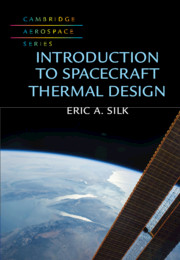Book contents
- Introduction to Spacecraft Thermal Design
- Cambridge Aerospace Series
- Introduction to Spacecraft Thermal Design
- Copyright page
- Dedication
- Contents
- Figures
- Tables
- Nomenclature
- Subscripts
- 1 Introduction
- 2 Conduction Heat Transfer Analysis
- 3 Radiative Heat Transfer Analysis
- 4 The Space Environment
- 5 Space-Based Advanced Thermal Conductance and Storage Technologies
- 6 Sensors, Instrumentation and Test Support Hardware
- 7 Fundamentals of Cryogenics
- 8 Developmental and Environmental Testing
- Book part
- Index
- Solutions
- References
8 - Developmental and Environmental Testing
Published online by Cambridge University Press: 19 June 2020
- Introduction to Spacecraft Thermal Design
- Cambridge Aerospace Series
- Introduction to Spacecraft Thermal Design
- Copyright page
- Dedication
- Contents
- Figures
- Tables
- Nomenclature
- Subscripts
- 1 Introduction
- 2 Conduction Heat Transfer Analysis
- 3 Radiative Heat Transfer Analysis
- 4 The Space Environment
- 5 Space-Based Advanced Thermal Conductance and Storage Technologies
- 6 Sensors, Instrumentation and Test Support Hardware
- 7 Fundamentals of Cryogenics
- 8 Developmental and Environmental Testing
- Book part
- Index
- Solutions
- References
Summary
In the development of spaceflight hardware systems, items are designed to perform in various operational environments. When the environment for intended use is considered extreme, the hardware in question undergoes ruggedization during the design phase to insure proper functionality once it is placed in the operational environment. The success of the measures taken during the design phase to ruggedize a system is verified by a test regime imposed at various levels of assembly that expose the hardware to environmental extremes comparable to, and slightly in excess of, what is expected in the operational theater. This is known as design, development and environmental testing. This chapter examines the philosophy behind environmental test practices for spaceflight thermal systems and looks at practical considerations associated with design and ground testing.
- Type
- Chapter
- Information
- Introduction to Spacecraft Thermal Design , pp. 333 - 340Publisher: Cambridge University PressPrint publication year: 2020



